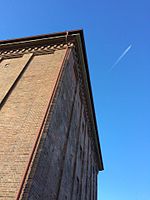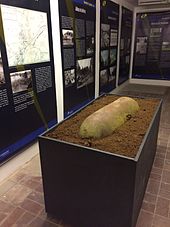German Bunker Museum
 Fichtel and Sachs bunker |
|
| Data | |
|---|---|
| place |
Schweinfurt Ernst-Sachs-Straße 73 |
| Art | |
| opening | 2014 |
| management |
Petra Brennecke
|
| Website | |
The German Bunker Museum in Schweinfurt deals with air and civil protection during the Second World War . It was opened in 2014 and is located in the Fichtel-und-Sachs bunker , which was originally referred to as the A8 bunker .
location
The Fichtel-und-Sachs-Bunker with the German Bunker Museum is located in the Oberndorf district , opposite the former headquarters of Fichtel & Sachs AG (today ZF Friedrichshafen AG ) at Ernst-Sachs-Straße 73.
Fichtel and Sachs bunker
Schweinfurt suffered 22 major air raids during World War II as it was the center of the war-important German ball bearing industry , a key industry . This is why the city had the best air defense in Germany and was only 40 to 45% destroyed, while neighboring Würzburg was 80% destroyed in an attack. The Americans experienced their greatest defeat in the air over Schweinfurt ( see: Schweinfurt # Second World War (Third City Destruction) ).
As part of the immediate Führer program , a total of 3,000 public bunkers were built throughout Germany from 1940 and ten public bunkers in Schweinfurt . Three additional bunkers in Schweinfurt served as a shelter for part of the workforce of the three large companies Fichtel and Sachs, Vereinigte Kugellagerfabriken AG (now part of Svenska Kullagerfabriken ) and Kugelfischer as so-called factory bunkers. In the Oberndorf district , the Riedel construction company (now the Riedel Bau Group) built the public bunker A8 in 1941 . The building is 20 × 21 meters in size and 19 meters high to the top of the bunker cover (top ceiling). A tent roof with a 25 degree incline was erected on the 1.40 meter thick cover to camouflage it . The roof structure was made entirely of concrete elements for fire protection reasons. The bunker has a basement with three meter thick walls. The ground floor and the four upper floors have walls two meters thick. The protective structure is characterized by its elaborate clinkering , into which dummy windows have been incorporated.
Officially, the bunker was allowed to be occupied by 1022 people. According to the calculations at the time, that was how many people had enough oxygen for twelve hours. Contemporary witnesses report permanent overcrowding. People also sought protection in the corridors and stairwells. Up to 1,800 people from Schweinfurt took refuge in the high bunker A8. During the war, the Fichtel and Sachs bunker was bombed when it was fully occupied. Except for a damage to the dummy roof, the building remained intact. After the war, people from Schweinfurt who had become homeless and refugees lived in the bunker . After that, the bunker served briefly as a warehouse for the Sachs works.
In 1983 the A8 bunker, like all public protective structures in Schweinfurt, was made usable again. Nationwide, around 500 of the 3,000 bunkers built in Germany were renovated during this time. The heating from 1941 was removed and an electrically operated ventilation system installed instead. Electrical and sanitary facilities were renewed and the inside of the bunker was plastered and painted white. A sand filter was installed on the fourth floor, which was supposed to cool and roughly filter hot and contaminated air drawn in from the outside by the ventilation system. 82 cubic meters of basalt - crushed sand with 120 tons were installed here. The bunker was supposed to withstand atomic, biological and chemical impacts and protect the occupants in the mid-1980s . Therefore, in 1983, all openings such as the coke and coal chute in the basement and the roof access through the bunker lid were poured with concrete. The descent into an escape tunnel, which led from the basement under the adjacent Karl-Schemmrich-Strasse into a pre-bunker, was closed with high-strength bridge concrete (only cement and basalt).
In a secret bidding process, the Federal Agency for Real Estate Tasks (BImA) finally sold the bunker to its current owners in 2014.
German Bunker Museum
organization
The German Bunker Museum in the Fichtel-und-Sachs-Bunker is home to exhibitions on civilian air defense during the Second World War in Germany. In addition to rare and bizarre exhibits, the exhibition "Schweinfurt in the air war" of the city of Schweinfurt (Stadtarchiv Schweinfurt 2013) will be shown. The exhibition extends over several floors within the bunker.
Every year in April the commemorative event for the end of the war takes place in Schweinfurt under the patronage of Schweinfurt's Lord Mayor Sebastian Remelé ( CSU ).
exhibition
Contemporary exhibits such as a neutralized dud from a US 250 kg high- explosive bomb , gas protection exhibits and many objects for civilian air defense are exhibited in the Schweinfurt Bunker Museum. The exhibition also deals with the Cold War . All exhibits have been sorted chronologically and prepared with attention to detail. The exhibition is constantly growing. In numerous cells - as the six m² large rooms in the bunker were called - scenes from the time are depicted with original bunker inventory. B. a luggage room with suitcases and other bulky items. A room with a bunker seating facility and a room with a bunker bed facility are shown. All rooms are decorated with exhibits from the 1930s and 1940s. Two rooms are dedicated to gas protection. Mothers (life-size dolls) are exhibited here, who protect their children from a possible poison gas attack with gas protection beds and gas protection jackets. A horse gas mask can also be seen. A shelter has been set up like the one provided by the Bundeswehr under staff buildings. These exhibits come from the original holdings of the Bundeswehr. The topic of communication is also presented in numerous showcases: people's receivers , field post letters , typewriters, literature and newspapers are on display in the bunker museum. One room deals with two sons of a well-known Schweinfurt building contractor family who died in World War II. The entire estate of the brothers who fell in 1944 and 1945 was donated to the bunker museum.
literature
- Nils Brennecke: Bunker Magazin , 2014
- Rolf Schamberger: Fascination with horror. An exhibition in the Schweinfurt air raid shelter . In: Silke Wenk (Ed.): Places of memory made of concrete. Bunkers in cities and landscapes . Ch. Links Verlag, Berlin 2001, ISBN 978-3-86153-254-5 , pp. 200-215.
Web links
- Fichtel and Sachs bunker in Schweinfurt - documentary film with contemporary witnesses
- Peter Hofmann: Schweinfurt guide - Fichtel-and-Sachs bunker
- Main-Post: On the day the Americans came
Individual evidence
- ^ Time travel in Schweinfurt - the Fichtel and Sachs bunker. In: www.tvtouring.de. Retrieved February 21, 2016 .
- ^ Bayerischer Rundfunk: Exhibition in Schweinfurt on April 11, 2015: End of the war 70 years ago | BR media library VIDEO. In: www.br.de. Archived from the original on January 2, 2016 ; accessed on February 21, 2016 .
- ↑ a b Fichtel and Sachs bunker, Schweinfurt. In: fichtelundsachsbunker.de. Retrieved February 21, 2016 .
- ^ Passauer Neue Presse: Schweinfurt commemorates the end of the war 70 years ago in the bunker. In: Bavaria - Upper Bavaria - Lower Bavaria - newspaper - news. Retrieved February 21, 2016 .
- ↑ German Bunker Museum now in Schweinfurt. (No longer available online.) In: SWity - Schweinfurt City. Archived from the original on December 13, 2016 ; accessed on December 13, 2016 . Info: The archive link was inserted automatically and has not yet been checked. Please check the original and archive link according to the instructions and then remove this notice.
- ↑ mh: Increasingly popular: Guided tours through the 1st Schweinfurt Bunker Museum - now also with an aerial bomb. In: Schweinfurt News News Current Events Events Party Disco Fete Fest Kino. Retrieved February 21, 2016 .
- ↑ The 1st Schweinfurt Bunker Museum is open. In: Revista Verlag. Retrieved February 21, 2016 .
- ↑ FOCUS Online: Schweinfurt commemorates the end of the war 70 years ago in the bunker. In: FOCUS Online. Retrieved March 26, 2016 .




